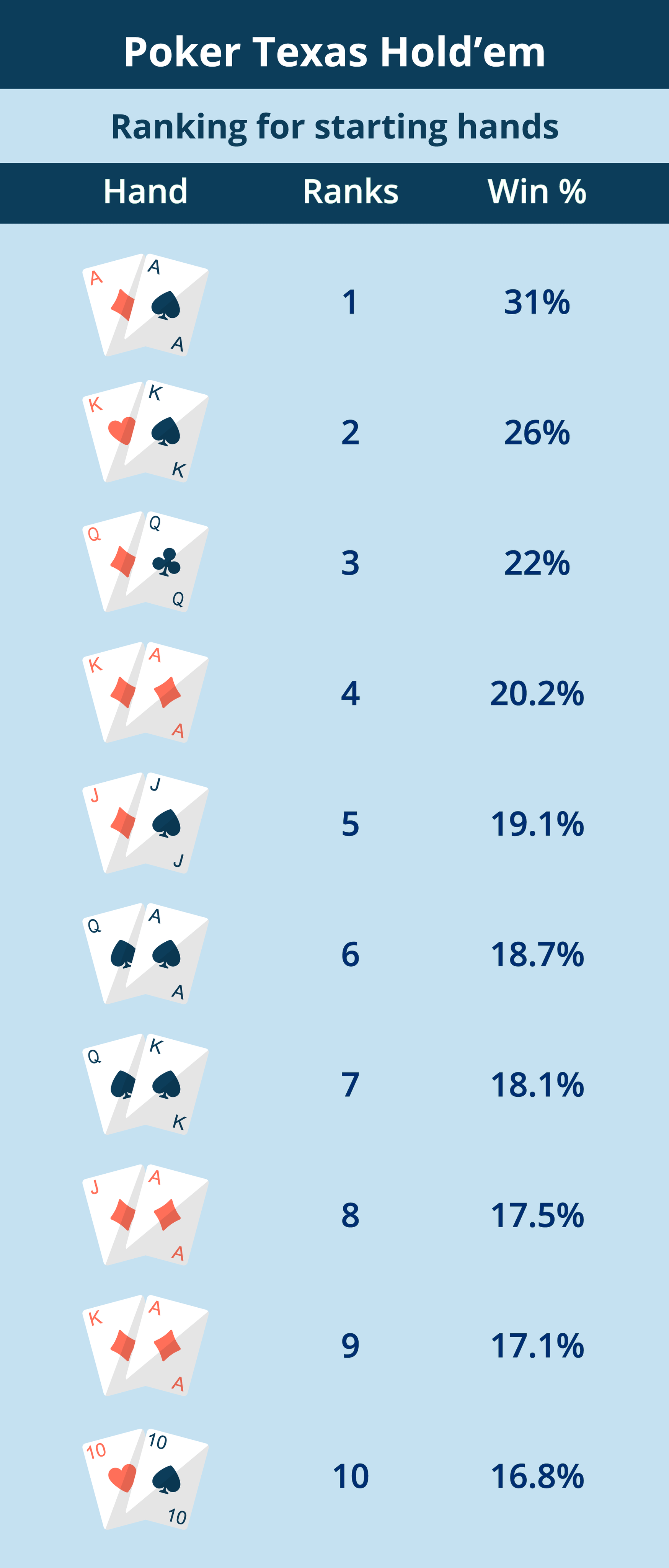Where to play the Best Texas Hold’Em Poker online?
With so many Canadian online casinos available, a player might feel overwhelmed with all the choices at hand.
To help you kickstart your journey in one of the most popular Poker variants, we at Canada Casino have hand-picked some of the best casinos that feature Texas Hold’em poker games.
Mastering the Rules & Odds of Texas Hold’Em
The reason why Texas Hold ‘em is a popular Poker Variant is that the rules are straightforward and fairly simple to learn.
Texas Hold’em is what is also known as a Community Card poker variant. In this poker method, the players are presented with a series of cards dealt face up – these are used by players to improve their Texas Hold’em hands.
Then, once the two cards are dealt face down to each player, bets are placed before and after the dealer exposes the first three cards (The Flop). Then these are followed by a fourth card (The Turn) and finally a fifth card (The River).
The odds for Texas Hold ‘em vary with the value of a player’s hand. This poker game’s ranking chart serves as a handy reference to calculate odds until players become familiar with the variety of poker hand combinations. Check out this handy table to get a grip on some Texas Hold’em Hands.

The Objective
Like all poker variants, the objective of Texas Hold ‘em is to win the combined bets that have accumulated in the pot. This does not necessarily mean winning every hand but rather achieving long-term winnings over the course of an entire game. The wins would be substantially more than the amount the player started with.
The Different Types of Bets in Texas Hold’Em
When to bet and what amount to bet is part of the constant decision-making process that poker players are challenged with. This skill is therefore crucial and serves as a core element to developing game-winning strategies.
When the betting opportunity is presented, poker players have five main options to choose from.
1. Call
Call refers to the announcement of one player calling another’s bet. More precisely, this is done by matching the amount wagered by another player with a Bet or a Raise.
2. Raise
Raising is the act of increasing the bet amount. By raising it, player challenges their opponents to meet the bet with a Call by re-raising or by folding.
A Raise is often associated with a strong hand or a Bluff.
3. Check
Players can check when they wish to make a pass on betting in a particular instance but keep their cards and the option to bet in the following rounds.
4. Fold
A player Folds when they want to exit the hand and relieve themselves from having to contribute to the pot.
The act of Folding is done by placing the cards face-down towards the dealer.
5. All-In
When a player goes All-In, they place all of their chips into the pot. This move signifies a player’s final bet and that they have no chips left.
RTP, Payouts and House edge in Texas Hold’Em
RTP, payouts and house edge are important decisive factors for a player to choose a game over the other. All of these outline the game’s winning possibilities and at what rate, and also the return you will get from your bet once you land wins.
RTP in Texas Hold’Em
Return to Player (RTP) is the amount of money a player can expect in return for their bet over a large number of games. The typical RTP for Texas Hold ’em is 97.82%. This means that on average, players can expect overtime to lose two cents on every dollar bet.
Live Casino Texas Hold ‘em games offer a higher RTP of 99.47%. – which is staggeringly high when compared with other poker variants.
Payouts in Texas Hold’Em
Texas Hold ‘em poker payouts are calculated on the value of the player’s poker hand. Poker hands are ranked between the highest (Royal Flush) and lowest (usually a Straight).
A Royal Flush pays out on the order of 500:1, Four of a Kind at 10:1 and the Straight at 1:1. The casinos provide a Hand Payout Chart of all the hands and corresponding payouts for quick reference. This follows the official standard poker hand rankings.
House Edge in Texas Hold’Em
House Edge is the percentage difference between the RTP and the 100% amount that was originally wagered. The general house edge for Texas Hold ‘em poker online at casinos is around 2.19%.
The house edge represents what the Casino will earn on every dollar bet. Players should be aware that both the RTP and House Edge are calculations based on thousands of hours of game time to produce a dependable average.
Texas Hold’Em vs. other Poker Variants
Texas Hold’Em may be one of the most popular poker versions, however other Poker Variants have been adapted over the years to accommodate different likes and needs of the player.
One of the most basic distinctive points of Texas Hold’em compared to other variants is that the game is played between the players and not against the bank.
We have also prepared the below table to outline basic features for some of the most popular poker variants. Find a poker variety similar to Texas Hold’em, here!
| | Texas Hold’Em | Pai Gow Poker | Caribbean Stud | Three Card |
|---|---|---|---|---|
| Bets | Raise, Call, Check, Fold, All In | Raise, Call, Check, Fold, All In | Raise, Call, Check, Fold, All In | Raise, Call, Check, Fold, All In |
| RTP | 97.81% | 92.23% – 97.45% | 94.97% | 97.15% |
| House edge | 2.19% | 2.84%+ | 5.22% | 3.37% – 1.5% |
| Category | Community | Double Hand | Stud | Stud |
The Difference between Texas Hold’em and Pai Gow poker
Adapted from a Chinese tile game similar to dominoes, Pai Gow poker is a popular choice for players looking for a slower-moving game than Texas Hold ‘Em.
Pai Gow poker is a Double Hand game that uses a fifty-two card deck and a single joker. Winning requires beating the banker/dealer/players by making two hands from the seven cards dealt.
Difference between Texas Hold’em and Caribbean Stud poker
Caribbean Stud Poker is first and foremost a casino table game. The biggest difference from Texas Hold ‘em poker is that players only have to beat the dealer, there are no opposing players.
Another key difference is that Caribbean Stud poker has only two distinct betting phases. This makes for a faster, less complex game that can be just as exciting as Texas Hold’em poker online.
Difference between Texas Hold’em and Three Card Poker
Three Card poker probably ranks second in popularity to Texas Hold ‘Em in the online casino world.
Three Card Poker has been around much longer and is far simpler to play with a basic betting structure. The game is simple and easy to learn – that is probably why it continues to be another favourite variant to poker.
Strategies for advanced players
Texas Hold ‘em is a game of skill as well as luck. Experienced players have built a set of strategies that can readily be adopted for just about any game scenario. Short of this, some fundamental approaches applied consistently will improve every player’s game.
Position Awareness
It’s all about table location. The best position in Texas Hold‘em is the dealer or ‘Button’ seat. It’s the last position to make decisions in three out of the four betting rounds, providing clear knowledge of what the other player’s bets and intentions are. The worst position is the Small Blind where a player is forced to act first.
Position awareness of the strengths and weaknesses of each seat at the table is a key strategic skill.
Price of The Flop
When holding a reasonably good starting hand, experienced players will raise the minimum bet to challenge opponents to meet that bet before the Flop is dealt.
Players with average hands will likely fold – this will eliminate part of the competition and can strengthen their weak opening hands.
Fold After Flop
If the Flop hasn’t improved your hand the chances are fairly good that it improved your opponents’.
While folding after the Flop may lose a few chips, experienced players would rather deal with a papercut than an amputation. Folding after the Flop is a cheap survival strategy.
Watch Opponents
Poker players bring a number of skills to the table – one of the most important is the skill of observation.
Spotting trends, tells and physiological changes that indicate frustration or excitement can make the difference between winning and losing the pot. Players should also constantly be aware of their opponents; chip stacks.
The High Art of Folding
Winning a Texas Hold‘em poker game, or most of the other poker games is as much about protecting the chip stack with the bets saved vs. the bets made. Knowing when to fold is a critical part of any successful poker strategy.
How to play Texas Hold’em – Breakdown of a round
1. The Blinds
Seated directly to the left of the dealer (Button) is the Small Blind. Two seats left of the dealer is the Big Blind. After the dealer issues two cards face down (hole cards) to all players, the Blinds are forced to place minimum bets to create the pot.
2. Pre-Flop
The first round of betting starts based on the two cards dealt with the player directly to the left of the Big Blind.
3. Flop
After the opening bets are placed, three cards are dealt onto the centre of the table face up. This trio of cards is available for all players to see and to make use of – this is referred to as the Flop.
Starting with the player directly to the left of the dealer, the second round of betting is concluded.
4. Turn
The dealer next adds another card to the community cards face up. This card is called the Turn, or Fourth Street.
After it has been dealt with, the third round of betting takes place with the same player order.
5. River
The dealer reveals the fifth and final card as face up, along with the other community cards. This card is known as the River or Fifth Street. The final round of betting takes place in the same player order as the previous one.
6. Showdown
The remaining players show their initial two hole cards and together with the dealer establish the winning hand.
In the case of a tie, the pot is split.
Easy beginners’ mistakes to avoid
Like in all Poker in general, beginners can quickly get caught up with the thrills of the game. Newbies must keep in mind that it takes time to develop a good strategy. A few typical errors common to rookies are easily corrected with a little effort.
Head Games
There’s more than Texas Hold ‘em being played at the table. The psychology of poker is part of any experienced player’s strategy. Keep a calm head and don’t be susceptible to mental distractions created by opponents to knock you off your game.
Bluffing
Novice players tend to think that bluffing is a common method to win a pot when the cards are cool. Then they always end up wondering why their bluffs are constantly called by opponents.
Players must understand that though Bluff is an art by itself, a successful bluff requires a number of other game knowledge that comes with experience and tactics. Learn to bluff before trying it and watch how experienced players do it.
Show Cards
Displaying a hand at the end of a round tells experienced players about your playing style – a sloppy one and generally frowned upon by those who follow poker etiquette.
It could also reveal your playing methods to opponents, who won’t hesitate to take advantage of that knowledge. Finish the round with the card’s faces down – just like the pros.






